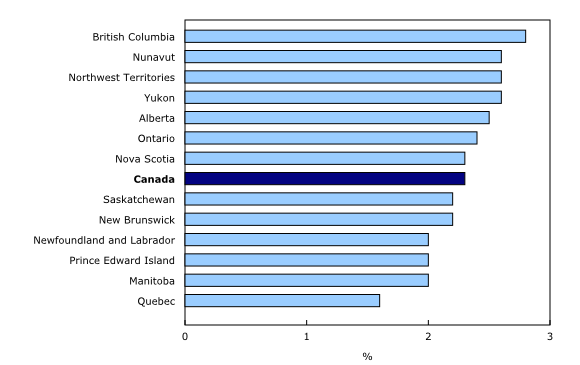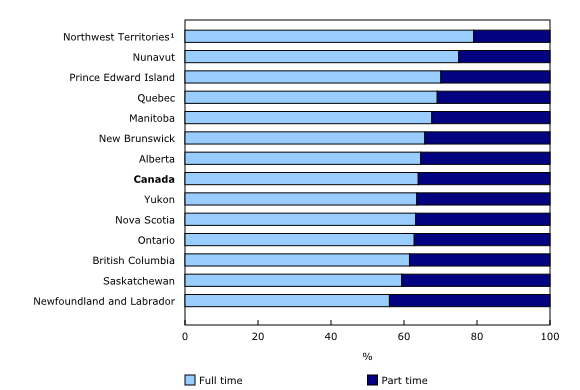Job Vacancy and Wage Survey, fourth quarter 2015
Archived Content
Information identified as archived is provided for reference, research or recordkeeping purposes. It is not subject to the Government of Canada Web Standards and has not been altered or updated since it was archived. Please "contact us" to request a format other than those available.
Released: 2016-05-12
Canadian employers reported 353,000 job vacancies in the fourth quarter, and the job vacancy rate was 2.3%.
Job vacancy rates across Canada
British Columbia had the highest job vacancy rate at 2.8%, followed by Nunavut, the Northwest Territories, and Yukon, which all had job vacancy rates of 2.6% in the fourth quarter. Quebec posted the lowest rate at 1.6%.
The job vacancy rate refers to the share of jobs that are unfilled out of all payroll jobs available. It represents the number of job vacancies expressed as a percentage of labour demand, that is, the sum of all occupied and vacant jobs.
Among the 76 economic regions in Canada, Banff–Jasper–Rocky Mountain House, Alberta, had the highest job vacancy rate at 3.6%, followed by two regions in British Columbia, Lower Mainland–Southwest and Northeast, both at 3.0%. Of the 10 economic regions with the highest job vacancy rates, 9 were in the western provinces. On the other hand, 9 of the 10 economic regions with the lowest job vacancy rates were in Quebec.
Job vacancies by occupation
Among the 10 broad occupational groups at the one-digit National Occupational Classification (NOC) level, sales and service occupations had the highest number of job vacancies at 143,000 or 40.4% of all job vacancies.
Retail salespersons had the largest number of vacancies (29,000) across all 140 three-digit NOC groups. In addition, among the 10 three-digit NOC groups with the most job vacancies, 7 were related to sales and service occupations.
At the broad occupational group level, trades, transport and equipment operators and related occupations had the second largest number of job vacancies at 48,000. Within this group, motor vehicle and transit drivers was the three-digit NOC group with the largest number of job vacancies (12,000).
Within business, finance and administration occupations (35,000 vacancies), auditors, accountants and investment professionals was the three-digit NOC group with the highest number of vacancies (6,900).
Job vacancies by industrial sector
The Job Vacancy and Wage Survey (JVWS) also provides data by industrial sector. Nationally, accommodation and food services registered a job vacancy rate of 3.7% in the fourth quarter, the highest of all industrial sectors. Provincially, the rate for this sector ranged from 2.0% in Quebec to 6.2% in Alberta.
Other sectors with above-average job vacancy rates included administrative and support, waste management and remediation services as well as agriculture, forestry, fishing and hunting, both at 3.4%. In contrast, educational services and utilities, both at 0.6%, as well as mining, quarrying, and oil and gas extraction (0.7%) had the lowest job vacancy rates in Canada.
Looking at the number of job vacancies nationally, retail trade had the largest number with 64,000, followed by accommodation and food services at 48,000. In contrast, utilities, which had the lowest job vacancy rate, also had the least number of vacancies at 700.
The distribution of job vacancies by sector varied across the country. For example, while Nova Scotia, Quebec and Manitoba together accounted for 21.0% of all job vacancies in the fourth quarter, they had 33.9% of all vacancies in health care and social assistance. Also, Alberta and British Columbia accounted for 31.0% of all job vacancies, but had 44.1% of all vacancies in construction.
Job vacancies and offered hourly wage
The JVWS provides data on the average wage offered for the job vacancies that businesses are trying to fill. The wage offered by an employer for a vacant position may differ from the actual wage paid once a position is filled (see the Guide to the Job Vacancy and Wage Survey for a detailed definition of average offered hourly wage).
The average offered hourly wage for all job vacancies was $18.95 in the fourth quarter. The territories had the highest offered wages, ranging from $21.20 in Yukon to $25.35 in the Northwest Territories. Provincially, Ontario had the highest offered wage at $19.35, followed by Manitoba and Quebec. Prince Edward Island was the province with the lowest offered wage for vacant positions at $14.15.
With the exception of Montréal ($21.75), the 10 economic regions with the highest offered wages were generally located in the northern part of their respective province. In contrast, the 10 economic regions with the lowest offered wages for vacant positions were mostly in the Atlantic provinces. The economic region of Northern Saskatchewan had the highest offered wage in the country at $26.50, while Annapolis Valley, Nova Scotia, and Prince Edward Island, both at $14.15, had the lowest.
The offered wage for job vacancies also varied within provinces. In Quebec, the offered wage ranged from $15.50 in Estrie to $21.75 in Montréal, while in Ontario, it ranged from $15.10 in Windsor–Sarnia to $20.60 in Ottawa. In Saskatchewan, the offered wage was lowest in Swift Current–Moose Jaw at $16.80 and highest in the Northern economic region at $26.50, making it the province with the largest sub-provincial variation in the offered wage in the country.
The offered wage for vacant positions related to an occupation could differ across provinces. For example, at the four-digit NOC level, the offered wage for vacant positions for transport truck drivers averaged $16.65 in Nova Scotia compared with $26.40 in Alberta. Similarly, the offered wage for construction trades helpers and labourers was $13.75 in Nova Scotia compared with $31.65 in Saskatchewan. Other occupations, however, had smaller provincial variations in terms of their offered wage. Among retail salespersons, the offered wage for vacant positions ranged from $11.00 in Newfoundland and Labrador and New Brunswick to $12.30 in Manitoba.
Among the 20 industrial sectors, utilities had the highest offered wage at $38.50, followed by mining, quarrying, and oil and gas extraction at $32.15. There were 1,500 job vacancies in mining, quarrying, and oil and gas extraction, and 700 job vacancies in utilities in the fourth quarter. Other sectors that had among the highest offered wages included public administration ($28.50), professional, scientific and technical services ($27.65), and educational services ($27.30).
Accommodation and food services was the sector that had the lowest offered wage for job vacancies ($12.20), followed by retail trade ($12.70). This partly reflected the fact that occupations in these two industrial sectors tended to have a higher proportion of job vacancies that were for part-time work.
Job vacancies by full-time and part-time status
Almost two-thirds of job vacancies in Canada were for full-time work. The Northwest Territories had the highest proportion of job vacancies that were for full-time work (79.1%). Among the provinces, Prince Edward Island (70.1%) and Quebec (69.1%) had the highest proportion of vacancies that were for full-time work, while Newfoundland and Labrador (56.0%) and Saskatchewan (59.4%) had the lowest.
Nationally, the average offered wage for job vacancies that were for full-time work was $21.40, which was $6.75 higher than the offered wage for vacancies that were for part-time work ($14.65). This tendency was also observed in all provinces and territories, with the largest differences between full-time and part-time offered wage being observed in Alberta ($7.75) and Ontario ($7.65), and the lowest being observed in Yukon ($0.80).
Differences in the offered wage by full-time and part-time status partly reflected the distribution of job vacancies by occupation. For example, retail salespersons and cashiers, two occupational groups that had among the lowest offered wages for vacant positions, represented 23.1% of job vacancies for part-time work compared with 3.6% of vacancies for full-time work.
Note to readers
The Job Vacancy and Wage Survey (JVWS) is a quarterly survey that provides comprehensive information on job vacancies by industrial sector, detailed occupations and skill level sought for Canada, the provinces, territories and economic regions. With its broader scope and greater detail, the JVWS is Statistics Canada's foremost source of current and comprehensive information on job vacancies in Canada.
The JVWS, sponsored by Employment and Social Development Canada, is the largest survey on job vacancies ever conducted by Statistics Canada. It responds to key labour market information needs by providing data on current and emerging labour market demand. Results will support decision making by job seekers, students, employers and policy makers.
JVWS data are not seasonally adjusted. Therefore, quarter-to-quarter comparisons should be interpreted with caution.
The annual wage and employment data by occupation started being collected for the wage component of the survey in 2016.
Summary statistics related to the job vacancy time series from the Survey of Employment, Payroll and Hours are available in CANSIM.
Occupations are classified according to the National Occupational Classification (NOC) 2011. The NOC is a four-tiered hierarchical structure of occupational groups with successive levels of disaggregation. The structure is as follows: 1) 10 broad occupational categories, also referred to as one-digit NOC; 2) 40 major groups, also referred to as two-digit NOC; 3) 140 minor groups, also referred to as three-digit NOC; and 4) 500 unit groups, also referred as to four-digit NOC.
Industrial sectors are classified according to the North American Industry Classification System (NAICS) 2012. The NAICS has 20 industrial sectors at the two-digit level.
Data quality of the Job Vacancy and Wage Survey
The target population of the survey includes all business locations in Canada, except for those primarily involved in religious organizations and private households. While federal, provincial and territorial administrations are also excluded from the survey for now, they will be phased in at a later date.
Next release
Job vacancy data from the JVWS for the first quarter will be released in August.
Products
More information about the concepts and use of data from the Job Vacancy and Wage Survey is available online in the Guide to the Job Vacancy and Wage Survey (75-514-G), from the Browse by key resource module of our website, under Publications.
Contact information
For more information, contact us (toll-free 1-800-263-1136; 514-283-8300; STATCAN.infostats-infostats.STATCAN@canada.ca).
To enquire about the concepts, methods or data quality of this release, contact Elton Cryderman (613-878-0323; elton.cryderman@canada.ca) or Myriam Hazel (613-219-4345; myriam.hazel@canada.ca), Labour Statistics Division.
- Date modified:



